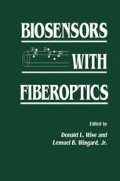Abstract
The availability of low-loss optical fibers with the associated benefits of freedom from electromagnetic interference, small size, light weight, and wide bandwidth has led to the development of sensors, both intrinsic and extrinsic. Commercial offerings of the extrinsic type, in which the sensing element is attached to the end of the fiber, are becoming readily available for the measurement of many physical and chemical parameters, e.g., temperature, pressure, and pH. The intrinsic sensors, in which the optical fiber itself functions as the sensor, potentially offer more sensitivity and versatility. In some cases, distance or location information may be obtained with intrinsic sensors by means of optical-pulse techniques. The intrinsic sensors are usually more complex in their instrumentation or environmental requirements, and their entry into the commercial market has proceeded more slowly.
Access this chapter
Tax calculation will be finalised at checkout
Purchases are for personal use only
Preview
Unable to display preview. Download preview PDF.
References
Harrick, N. J. (1967)Internal Reflection Spectroscopy(Wiley, New York).
Hirschfeld, T. (1965) Total reflection fluorescence.Can. Spectroscopy 10128.
Hirschfeld, T. (1987) Apparatus for improving the numerical aperture at the input of a fiber optics device. US Patent 4,654,532.
Love, W. F. and Slovacek, R. E. (1986)Fiber optic evanescent sensor for fluoroimmunoassay. Paper 6.6 presented at the 4th Int. Conference on Optical Fiber Sensors (OFS ‘86, Tokyo, Japan).
Glass, T. R., Lackie. S., and Hirschfeld, T. (1987) Effect of numerical aperture on signal level in cylindrical waveguide evanescent fluorosensors.Appl. Opt. 262181.
Lee, E. H., Benner, R. E., Fenn, J. B., and Chang, R. K. (1979) Angular distribution of fluorescence from liquids and monodispersed spheres by evanescent wave excitation.Appl. Opt. 18862.
Carniglia, C. K., Mandel, L., and Drexhage, K. H. (1972) Absorption and emission of evanescent photons.J. Opt. Soc.Am. 62, 479.
Lukosz, W. and Kunz, R. E. (1978) Light emission by magnetic and electric dipoles close to a plane interface. I. Total radiated power.J. Opt. Soc. Am. 671607.
Lukosz, W. and Kunz, R. E. (1978) Light emission by magnetic and electric dipoles close to a plane interface. II. Radiation patterns of perpendicular oriented dipoles.J. Opt. Soc. Am. 671615.
Lukosz, W. (1979) Light emission by magnetic and electric dipoles close to a plane interface. III. Radiation patterns of dipoles with arbitrary orientation.J. Opt. Soc. Am. 691495.
Carniglia, C. K. and Mandel, L. (1971) Quantization of evanescent electromagnetic waves.Phys. Rev. D. 3280.
Snyder, A. W. and Love, J. D. (1983) Bound rays of fibers (Chapter 2), pp. 26–50; Fiber illumination and pulse shape (Chapter 4), pp. 63–88; Leaky rays (Chapter 7), pp. 134–153; in Optical Waveguide Theory(Chapman and Hall, New York).
Boyd, R. W. (1983)Radiometry and the Detection of Optical Radiation(Wiley, New York).
Born, M. and Wolf, E. (1980) Reflection and refraction of a plane wave, inPrinciples of Optics6th Ed. (Pergamon, Elmsford, NY), pp. 36–51.
Editor information
Editors and Affiliations
Rights and permissions
Copyright information
© 1991 Springer Science+Business Media New York
About this chapter
Cite this chapter
Love, W.F., Button, L.J., Slovacek, R.E. (1991). Optical Characteristics of Fiberoptic Evanescent Wave Sensors. In: Wise, D.L., Wingard, L.B. (eds) Biosensors with Fiberoptics. Contemporary Instrumentation and Analysis. Humana Press, Totowa, NJ. https://doi.org/10.1007/978-1-4612-0483-1_5
Download citation
DOI: https://doi.org/10.1007/978-1-4612-0483-1_5
Publisher Name: Humana Press, Totowa, NJ
Print ISBN: 978-1-4612-6782-9
Online ISBN: 978-1-4612-0483-1
eBook Packages: Springer Book Archive

